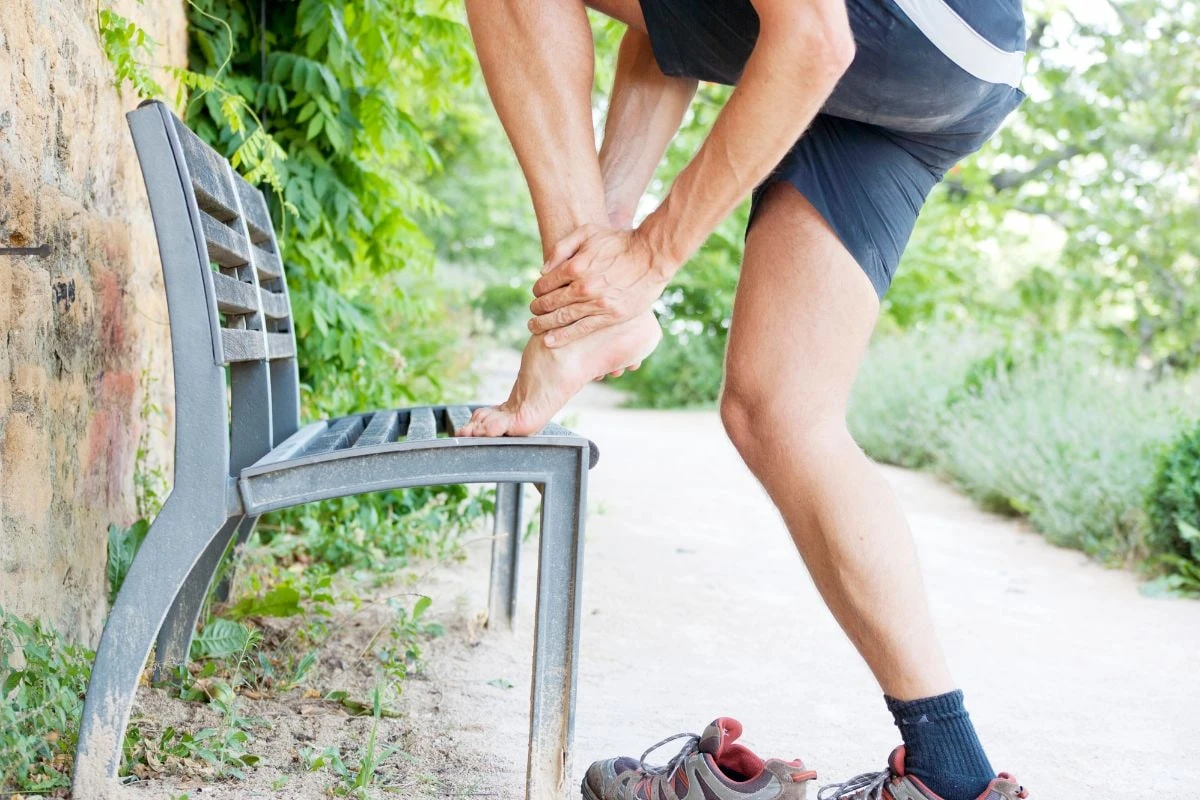There are several reasons why a person might suffer from pain at the back of their heel, but the most common condition associated with that pain is called Achilles tendonitis.
In this article, we’ll look at some of the most common causes of pain at the back of the ankle, including Achilles tendonitis. We’ll also look at other causes of pain, in the area, and look at possible treatments that can prevent ankle pain and reduce swelling.
Very mild pain in the back of the ankle can often be relieved with rest for a few days, or even a few weeks. When there is more severe pain, or things aren’t working to relieve pain, you should contact a physiotherapist.
In extreme cases, for things like broken ankles, ankle fractures, and chronic lateral ankle pain where there is especially intense pain, physical therapy might not be enough: foot and ankle surgeons might have to be called in.
Read on to find out more about pain in the back of your heel, ways to diagnose the problem, and possible solutions.
Struggling with pain at the back of your ankle? Book in to see one of the physiotherapists at Align Health Collective to get on top of ankle pain.
What is the Achilles tendon?
The Achilles tendon is a large tendon also known as the ‘heel cord’ or the ‘calcaneal tendon’. It’s the thickest tendon in the human body and, to simplify a little bit, it connects the leg to the foot.
It takes its name from the Greek mythological hero Achilles, who was immortal with a single weakness: his ankle. Achilles is an apt name for the large tendon in our heel: this tendon has been the cause of pain and trouble for many people over the years!

What is Achilles tendonitis?
Achilles tendonitis cost commonly occurs in runners who increase the duration and/or intensity of their runs. It is an ‘overuse’ injury, meaning that it isn’t necessarily a sudden injury, but one that can build up into a problem where you feel pain over time.
The main symptom of Achilles tendinitis is pain at the back of an ankle. It may also cause tightness and pain slightly higher up, at the back of the leg, up into the middle of the calf muscles.
Achilles tendonitis is not exclusively a problem for runners; people who have to climb stairs for a long period of time can also have problems. Many factors can increase your chances of suffering from Achilles tendinitis, such as:
- Sex: Men most commonly suffer from Achilles tendonitis
- Age: The older you get, the more foot problems and issues relating to soft tissues emerge, and the more common Achilles tendonitis becomes.
- Physical issues: People with flat arches tend to have more difficulties with the Achilles tendon.
- Inappropriate gear: Your shoes can make a big impact on whether or not you start suffering from Achilles tendonitis. As well as ankle pain, you might be causing yourself some foot and lower leg problems. Things like a better walking boot, soft insoles and arch supports can all make a difference.
If you start to notice pain at the back of the ankle or in the calf muscle, start by resting your leg. Therapeutic massage can be helpful. If the pain gets worse, or persistently doesn’t get better, book in to see a physiotherapist.
What are other causes of ankle pain?
Many things might cause ankle pain, from severe injuries to merely having flat feet and wearing shoes that are the wrong size. A few other heel pain issues include:
- Injuries: Fractures, sprains, bursitis, tendonitis,
- Arthritis: When cartilage breaks down, bones rub together, and this can cause ankle pain.
- Flatfoot: Low arches are a cause of pain and swelling in many people’s ankles and feet.
- Gout: Also known as king’s disease, gout is a form of arthritis from the buildup of uric acid. With gout, the excess uric acid results in needle-shaped crystals settling in the joints. This can be especially painful in the ankle and low heel regions.
- Infection: If an infection gets past your immune system, the result can be a pain in the back of your ankle. For example, cellulitis can cause real problems for the ankle.
Is there something wrong with my heel bone?
Some ankle issues are to do with the Achilles tendon, while other kinds of ankle pain might have to do with your heel bone. If you’ve suffered an injury and are continuing to suffer ankle pain and ankle swelling, visit a physiotherapist to find out more about treating pain and understanding which part of your heel needs attention.
Who can help with my ankle pain and foot pain?
The right person to see for treatment for ankle pain and foot pain will depend on the nature of the pain you are experiencing. If you’ve had a serious injury, are experiencing extraordinary pain, and suspect that you might have a broken ankle or foot, head to the emergency department.
However, if the pain feels more like it is in the ankle joint, something like a sprained ankle or Achilles tendinitis, a physical therapist in Melbourne will be able to help. For many physiotherapists, you don’t even need to head to a doctor first to get a referral. Just call up the practice and make an appointment.
How do physical therapists help with ankle pain?
Physical therapy can help to reduce pain from ankle issues, from an ankle sprain to rheumatoid arthritis. Treatment depends on the nature of the ankle injury, pain or disease. It might be enough to just use ice packs and refrain from physical activity, or surgical repair may be called for.
Our specialised team at Align Health Collective can help with all sorts of ankle pain. Book in today to talk to one of our physiotherapists and take the first step to relieve your pain.
